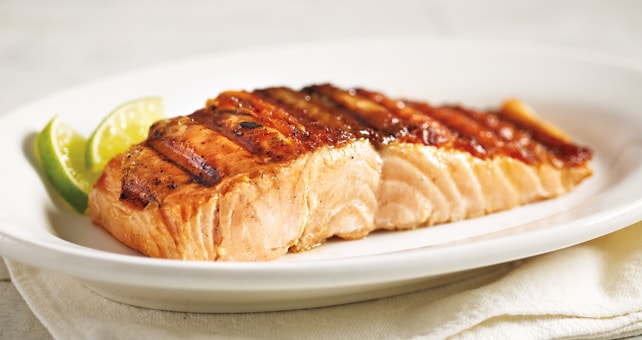Go ahead . . . dive in!
You know those rare foods that are really, really delicious—we mean crave-worthy—but can also play a major role in a healthy diet? That's seafood. Absolutely delicious and a good source of protein and omega 3’s, seafood is something we should enjoy on a regular basis.
In fact, because fish and shellfish can be such a great part of an overall healthy eating pattern, the Dietary Guidelines for Americans, 2020-2025, generally recommend consuming 8 ounces of seafood per week. Government and health organizations recommend eating seafood twice each week.
Lean, mean, protein machines.
Fish are often a lean source of protein with less fat per serving than red meats. In other words, you'll need to consume fewer calories to meet your daily protein needs. One three-ounce serving of fish provides about one-third of the daily recommended protein. As a bonus, fish is easier to digest than meat and poultry because of less connective tissue—the same reason it flakes so easily under a fork.
Don't fear this fat. It's kind to you.
Supportive but not conclusive research shows that consumption of EPA and DHA omega-3 fatty acids may reduce the risk of coronary heart disease. Our bodies don’t make omega-3 fatty acids, so we must get them from our food. There's strong scientific evidence to suggest omega-3 fatty acids reduce the risk of heart disease (the leading cause of death in Western countries), by lowering triglycerides and blood pressure. They may also help with healthy joints, mental well-being, prenatal brain development, and many other aspects of health.
Fattier fish—like cooked farmed Atlantic salmon—typically contain 1825 milligrams of omega-3 fatty acids per serving. But even options with less fat, such as cooked haddock and scallops, contain, respectively, 136 milligrams and 88 milligrams of EPA and DHA omega-3 fatty acids per serving.
The cholesterol myth
Animal foods contain cholesterol, so like anything else, they should be eaten in moderation, as part of a balanced diet. However, contrary to previous belief, many types of seafood are actually low in cholesterol.
In addition, most shellfish—including shrimp, oysters, clams, crabs, and mussels—can still have a place in a cholesterol-conscious diet. Shrimp contain higher amounts of cholesterol, at approximately 137 milligrams per three-ounce serving. And squid is one of the rare seafoods with elevated cholesterol, with approximately 200 milligrams per three-ounce serving. But as you can see, the cholesterol content in seafood is simply not a major concern, and for most people, seafood can be part of a healthy diet.
So . . . what's for dinner?
How about savory Mediterranean scallops and artichoke-mushroom pasta? Lemony, sautéed balsamic fish with orzo? Or deliciously smoky paprika fish tacos with black bean-pineapple salsa?
Check these and other seafood recipes for enjoying the taste—and health benefits—of fish on a regular basis.
Have another fish in mind that you don’t see featured at Publix? Let us know. We can order any fish you like!
Source: U.S. Department of Health & Human Services (HHS). "A Closer Look Inside Healthy Eating Patterns: About Seafood." 2015–2020 Dietary Guidelines for Americans, 8th ed. November 21, 2016.

 You are about to leave publix.com and enter the Instacart site that they operate and control. Publix’s delivery and curbside pickup item prices are higher than item prices in physical store locations. Prices are based on data collected in store and are subject to delays and errors. Fees, tips & taxes may apply. Subject to terms & availability. Publix Liquors orders cannot be combined with grocery delivery. Drink Responsibly. Be 21. For prescription delivery, log in to your pharmacy account by using the Publix Pharmacy app or visiting
You are about to leave publix.com and enter the Instacart site that they operate and control. Publix’s delivery and curbside pickup item prices are higher than item prices in physical store locations. Prices are based on data collected in store and are subject to delays and errors. Fees, tips & taxes may apply. Subject to terms & availability. Publix Liquors orders cannot be combined with grocery delivery. Drink Responsibly. Be 21. For prescription delivery, log in to your pharmacy account by using the Publix Pharmacy app or visiting 